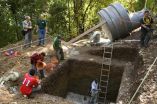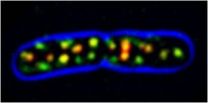(Press-News.org) An unusual signal detected by the seismic monitoring station at the Smithsonian Tropical Research Institute's research facility on Barro Colorado Island results from waves in Lake Gatun, the reservoir that forms the Panama Canal channel, scientists report. Understanding seismic background signals leads to improved earthquake and tsunami detection in the Caribbean region where 100 tsunamis have been reported in the past 500 years.
As part of a $37.5 million U.S. presidential initiative to improve earthquake monitoring following the devastating tsunami in the Indian Ocean in 2004, a seismic sensor was installed on Barro Colorado Island in 2006. The sensor is one of more than 150 sensors that comprise the U.S. Geological Survey's Global Seismographic Network.
Barro Colorado Island is a hilltop that was isolated by the waters of the reservoir created when the Chagres River was dammed to form Lake Gatun, a critical part of the Panama Canal. The Barro Colorado seismic monitoring station is a collaboration between the U.S. Geological Survey, the U.S. National Oceanic and Atmospheric Administration, the University of Panama and STRI.
Ultra-sensitive devices at the station pick up a large range of ground motion from felt earthquakes to nanometer-scale seismic background noise. The instruments at the station include very sensitive broadband seismometers used to detect distant earthquakes and low-gain accelerometers that measure ground movement and withstand violent local earthquakes and explosions.
The sensors detect signals from many different sources that include cars, boats and machinery operating up to several kilometers away. They also pick up the background "hum of the Earth" caused by ocean waves breaking on continental shelves around the world.
Scientists noticed that sensors on Barro Colorado recorded an intriguing wave pattern at an intermediate frequency. They suspected that this pattern could be caused by standing waves in Lake Gatun. Standing waves, also known as "seiches," are common in enclosed bodies of water like lakes and harbors where waves moving in opposite directions interact. By installing a water-level detection meter along the shoreline, researchers confirmed that changes in the water level of the lake correspond to the unusual seismic signal.
This is not the first report of seiches in Lake Gatun. Earlier reports correlated the release of methane gasses in the sediments below the canal to seiches and bottom currents in the lake. The Panama Canal Authority provided data about the depth of the Canal channel and of Lake Gatun that the authors used to model wave patterns in the lake.
Boat traffic and wind speed correlate with the unusual wave pattern, which was more common during the day than it was at night, but more information is needed to confirm what is actually causing the waves.
This report, published in the Journal of Geophysical Research, provides a new method to quantify the impact of water movements as recorded by land-based seismometers. A more exact understanding of the seismic signals resulting from water movements will improve estimates of other phenomena like tsunami impacts.
INFORMATION:
The Smithsonian Tropical Research Institute, headquartered in Panama City, Panama, is a unit of the Smithsonian Institution. The Institute furthers the understanding of tropical nature and its importance to human welfare, trains students to conduct research in the tropics and promotes conservation by increasing public awareness of the beauty and importance of tropical ecosystems. Website: www.stri.org. STRI Herbarium: www.stri.org/herbarium.
Citation: D.E. McNamara, A.T. Ringler, C.R. Hutt and L.S. Gee (2011), Seismically observed seiching in the Panama Canal, J. Geophys. Res., 116, B04312, doi: 10.1029/2010JB007930.
Tsunami sensor detects mysterious background signal in Panama
2011-06-04
ELSE PRESS RELEASES FROM THIS DATE:
Helping the aged during natural disasters
2011-06-04
When earthquake, tsunami, tornado or flood strike, among the most vulnerable group are the elderly. Writing in the International Journal of Emergency Management, researchers in New Zealand suggest that emergency response plans must take into account the age-related needs of adults with regards to the personal and social resources they have available.
Robyn Tuohy and Christine Stephens of Massey University in Palmerston North, point out that elderly citizens are likely to experience the negative impacts of floods and other natural disasters partly because of age-related ...
New strategy to combat cystitis
2011-06-04
Brussels - One in three women will be faced at least once in her life with cystitis, for some the start of a constantly recurring infection. Cystitis is caused by Escherichia coli bacteria which fasten on to the wall of the bladder by means of thread-like structures (pili). Han Remaut of the VIB Department for Structural Biology Brussels, Vrije Universiteit Brussel reveals for the first time the complex interactions which lead to the formation of these pili. This knowledge can be used to develop new antibiotics to treat infections of the urinary tract.
Cystitis
Around ...
Letters from home may help prevent post-traumatic stress disorder in happily married soldiers
2011-06-04
A new study from the Journal of Traumatic Stress finds that for active-duty male soldiers in the U.S. Army who are happily married, communicating frequently with one's spouse through letters and emails during deployment may protect against the development of posttraumatic stress disorder (PTSD) symptoms after returning home.
After studying information from 193 married male Army soldiers who returned from military deployment within the past year, investigators found that more frequent spousal communication through "delayed" communication such as letters, care packages, ...
Fast track to vascular disease
2011-06-04
In Western societies, atherosclerosis of the arteries is one of the leading causes of death. Chronic, localized inflammation of the blood vessel wall facilitates the growth of fibrous plaques, which leads to narrowing or occlusion of the vessel, and thereby promotes heart attacks and stroke. The persistence of the inflammatory reaction is due to a loss of control over the activity of the immune system. So-called dendritic cells are known to play a central role in the adaptive immune response, functioning as activators of other classes of immune cells. Their precise contribution ...
Not all hospitals treat elderly the same
2011-06-04
TORONTO, Ont., June 3, 2011—Hospitals that provide quality care for young people do not always provide the same quality care for the elderly, a new study has found.
As our population ages and requires more healthcare, hospitals need to measure the quality of care they provide for the over 65s and implement programs to meet their distinct needs, said the study's author, Dr. Avery Nathens, trauma director at St. Michael's Hospital.
The study, published in the June issue of the Journal of the American College of Surgeons, evaluated the condition of elderly patients 30 ...
BUSM study finds older men more likely to lose the ability to orgasm due to gabapentin
2011-06-04
(Boston) - Boston University School of Medicine (BUSM) researchers have found that Gabapentin, (trade name Neurontin) a medication commonly used to treat neuropathic pain, seizures and biopolar disease in older and elderly patients, seems to have a higher incidence of anorgasmia, or failure to experience orgasm, than previously reported. This study appears in the current issue of the American Journal of Geriatric Pharmacotherapy.
Anticonvulsants are the fastest growing prescribed medication in the baby boomer generation. In patients 44-82 years old, anticonvulsants are ...
Bacterial roundabouts determine cell shape
2011-06-04
Almost all bacteria owe their structure to an outer cell wall that interacts closely with the supporting MreB protein inside the cell. As scientists at the Max Planck Institute for Biochemistry and at the French INRA now show, MreB molecules assemble into larger units, but not - as previously believed – into continuous helical structures. The circular movement of these units along the inside of the bacterial envelope is mediated by cell wall synthesis, which in turn requires the support of MreB. This mutual interaction may be a widespread phenomenon among bacteria and opens ...
Paper and computer workarounds challenge but may improve health IT
2011-06-04
INDIANAPOLIS – A new research study investigates the challenges that pen and paper workarounds or computerized communication breakdowns pose to the use of electronic health records. Understanding these challenges may lead to improved coordination of care supported by health IT.
Focusing on referrals by primary care physicians to specialists and communications from the specialists back to the referring physician, "Paper Persistence, Workarounds, and Communication Breakdowns in Computerized Consultation Management" appears in the July 2011 issue of the International Journal ...
Study finds vaccine extends recurrent GBM survival rates by 2 to 3 times
2011-06-04
In data presented at The American Society of Clinical Oncology (ASCO) Annual Meeting, cancer researchers found that the brain tumor vaccine HSPPC-96 for treating recurrent gliobastoma (GBM) has a favorable safety profile and extends survival by two to three times more than the current median survival rate. Patients in the study, conducted at University Hospitals Case Medical Center, University of California, San Francisco and Columbia University, were found to have a median survival of 11 months compared to current three to five month survival.
"The findings are very ...
MedWOW's Global Medical Eqiupment Platform Strengthens Franchise Team
2011-06-04
Due to increasing international demand, MedWOW greatly expanded its operations by launching a Global Franchise Program. MedWOW's Franchise Program screens qualified medical equipment professionals throughout the world, in order to find the best representatives to join the MedWOW brand and offer the website's services in their defined territory.
The franchise program offers reputable key-players in the medical equipment industry the opportunity to expand their existing business, by giving them the rights to market MedWOW to end-users in their territories, including: ...



